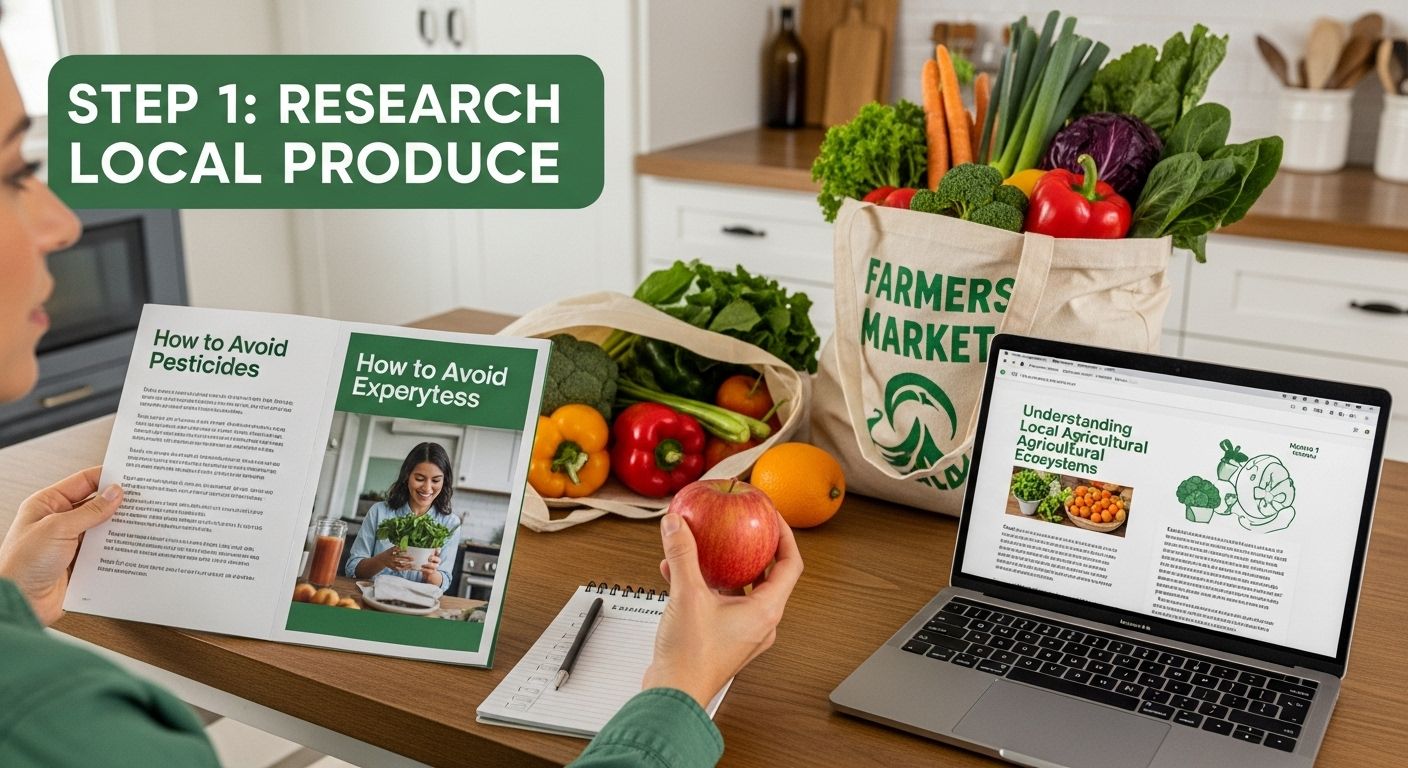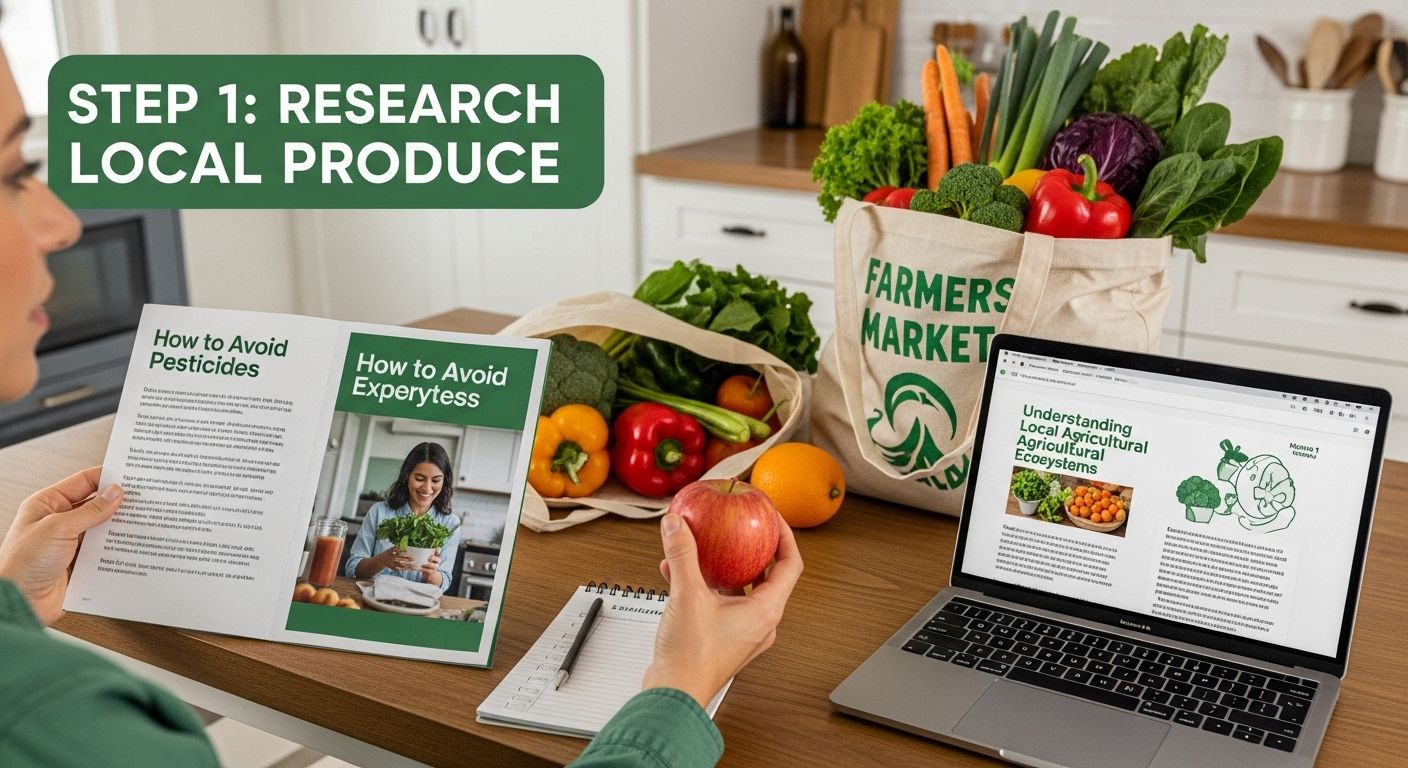
Cutting pesticides from your daily diet sounds simple, yet the truth is most supermarket produce exposes you to a surprising amount of agricultural chemicals every day. Many believe organic options are just a pricey trend, but consider this. Research shows consumers who accurately interpret food certification labels actually consume significantly fewer agricultural chemicals. The real shift begins when you stop relying on guesswork and start treating your food choices like a science.
Table of Contents
- Step 1: Research Local Produce Sources
- Step 2: Understand Food Labels and Certifications
- Step 3: Choose Organic and Pesticide-Free Options
- Step 4: Prepare Your Home and Kitchen Environment
- Step 5: Implement Safe Food Washing Techniques
- Step 6: Verify Your Food Choices Regularly
Quick Summary
| Key Point | Explanation |
|---|---|
| 1. Research local produce sources | Understand your local agricultural landscape to engage with safer, cleaner food options openly. |
| 2. Decipher food labels and certifications | Learn to interpret food labels to effectively reduce exposure to agricultural chemicals. |
| 3. Choose organic and pesticide-free options | Prioritise purchasing organic products, especially those prone to high pesticide residues. |
| 4. Implement thorough food washing techniques | Use natural methods to clean produce adequately, reducing pesticide residues before consumption. |
| 5. Regularly verify food choices | Continuously monitor your food sources and practices to adapt to changes in agricultural standards. |
Step 1: Research Local Produce Sources
Reducing pesticide exposure begins with understanding your local produce landscape. This crucial first step involves strategically investigating sources that offer cleaner, safer agricultural products. By focusing on local agriculture, you create opportunities to directly engage with food production methods and minimise chemical contamination risks.
Understanding Local Agricultural Ecosystems
Knowing where your produce originates is fundamental in avoiding pesticides. Local farmers’ markets, community supported agriculture (CSA) programmes, and small regional farms often represent superior alternatives to mass-produced supermarket offerings. These local sources typically maintain more transparent agricultural practices and frequently use reduced or organic pest management techniques.
Start by mapping out agricultural resources within your region. Contact local agricultural extension offices, search online directories, or visit neighbourhood farmers’ markets. Engage directly with farmers about their cultivation methods. Ask specific questions regarding pest control strategies, fertiliser usage, and organic certification. Many small-scale farmers implement integrated pest management approaches that minimise chemical interventions.
According to research from the International Journal of Environmental Research and Public Health, supporting local agriculture provides significant advantages in reducing dietary pesticide exposure. By establishing direct relationships with producers, you gain insights into their agricultural practices and can make more informed purchasing decisions.
Key verification criteria for identifying low-pesticide produce sources include:
- Farms with organic certification
- Producers using integrated pest management
- Agricultural operations demonstrating transparent growing practices
- Local producers willing to discuss their cultivation methods
Successful completion of this step means developing a comprehensive understanding of your local agricultural ecosystem and identifying multiple produce sources that prioritise minimal chemical intervention.
Step 2: Understand Food Labels and Certifications
Navigating the complex world of food labels requires strategic knowledge to effectively reduce pesticide exposure. This step transforms you from a passive consumer into an informed purchaser who can decode the subtle language of agricultural certifications and product descriptions.
Deciphering Organic and Low-Pesticide Indicators
Understanding certification labels is your primary defence against hidden chemical treatments. Not all labels mean the same thing, and learning to distinguish between them can significantly reduce your pesticide intake. Organic certification represents the most rigorous standard, with USDA Organic and European Organic labels indicating strict regulations about chemical usage.
Look beyond simple organic claims. Certifications like Certified Naturally Grown or Demeter Biodynamic often represent even more comprehensive agricultural practices that minimise synthetic interventions. These labels suggest farmers use holistic ecosystem management rather than relying on chemical pest control methods.
According to research published in the Environmental Health Perspectives journal, understanding these labels can substantially reduce your potential pesticide exposure. The study highlights that consumers who carefully interpret certification standards consume significantly fewer agricultural chemicals.
Key verification criteria for interpreting food labels include:
- Checking for official certification logos
- Understanding the specific standards behind each label
- Recognising the difference between “organic” and “natural” claims
- Investigating the certification body’s reputation and standards
Successful completion of this step means developing a nuanced understanding of food labelling systems, enabling you to make informed purchasing decisions that prioritise low-pesticide produce. Your newfound label literacy transforms shopping from a routine task into a strategic health intervention.
Step 3: Choose Organic and Pesticide-Free Options
Transitioning to organic and pesticide-free foods represents a powerful strategy for minimising chemical exposure in your diet. This step involves making intentional purchasing decisions that prioritise produce grown with minimal synthetic interventions.
Strategic Organic Food Selection
Organic certification provides your strongest guarantee against pesticide contamination. While organic products might cost slightly more, they represent a critical investment in your long-term health. Prioritise purchasing organic versions of produce most susceptible to high pesticide residues, often referred to as the “Dirty Dozen” list, which includes strawberries, spinach, kale, and apples.
When shopping, develop a systematic approach to organic selection. Compare conventional and organic options, understanding that the additional cost reflects more sustainable agricultural practices. Look for USDA Organic or European Organic certifications, which mandate strict regulations about chemical usage. Learn more about identifying organic products effortlessly to make informed choices.
According to research published in the National Center for Biotechnology Information, organic foods consistently demonstrate lower pesticide residue levels compared to conventionally grown alternatives. This scientific evidence underscores the importance of conscious food selection.
Key verification criteria for selecting pesticide-free options include:
- Prioritising organic certification
- Checking for comprehensive labelling
- Understanding produce vulnerability to pesticide absorption
- Comparing organic options across different product categories
Successful completion of this step means transforming your shopping habits to consistently choose produce that minimises potential chemical exposure, protecting your health through informed dietary decisions.
Step 4: Prepare Your Home and Kitchen Environment
Creating a pesticide-free home environment extends beyond food selection, requiring strategic cleaning and food preparation techniques. This step transforms your kitchen into a protective zone that minimises chemical contamination risks and supports your health objectives.
Comprehensive Kitchen Decontamination Strategies
Washing produce thoroughly represents your first line of defence against pesticide residues. Develop a consistent cleaning ritual that goes beyond simple rinsing. Utilise a combination of water and white vinegar solutions to effectively remove surface chemical traces. For leafy greens and delicate produce, create a gentle washing solution using one part white vinegar to three parts water, soaking items for several minutes before thorough rinsing.
Invest in specific tools designed for produce cleaning. Vegetable brushes with soft bristles can help remove residual dirt and potential chemical deposits from firmer produce like potatoes, carrots, and apples.
Avoid using commercial produce wash solutions, which often contain additional chemicals. Instead, rely on natural, simple cleaning methods that mechanically remove surface contaminants.
Consider your food storage strategies as another critical aspect of pesticide reduction. Store organic and carefully washed produce separately from conventionally grown items.
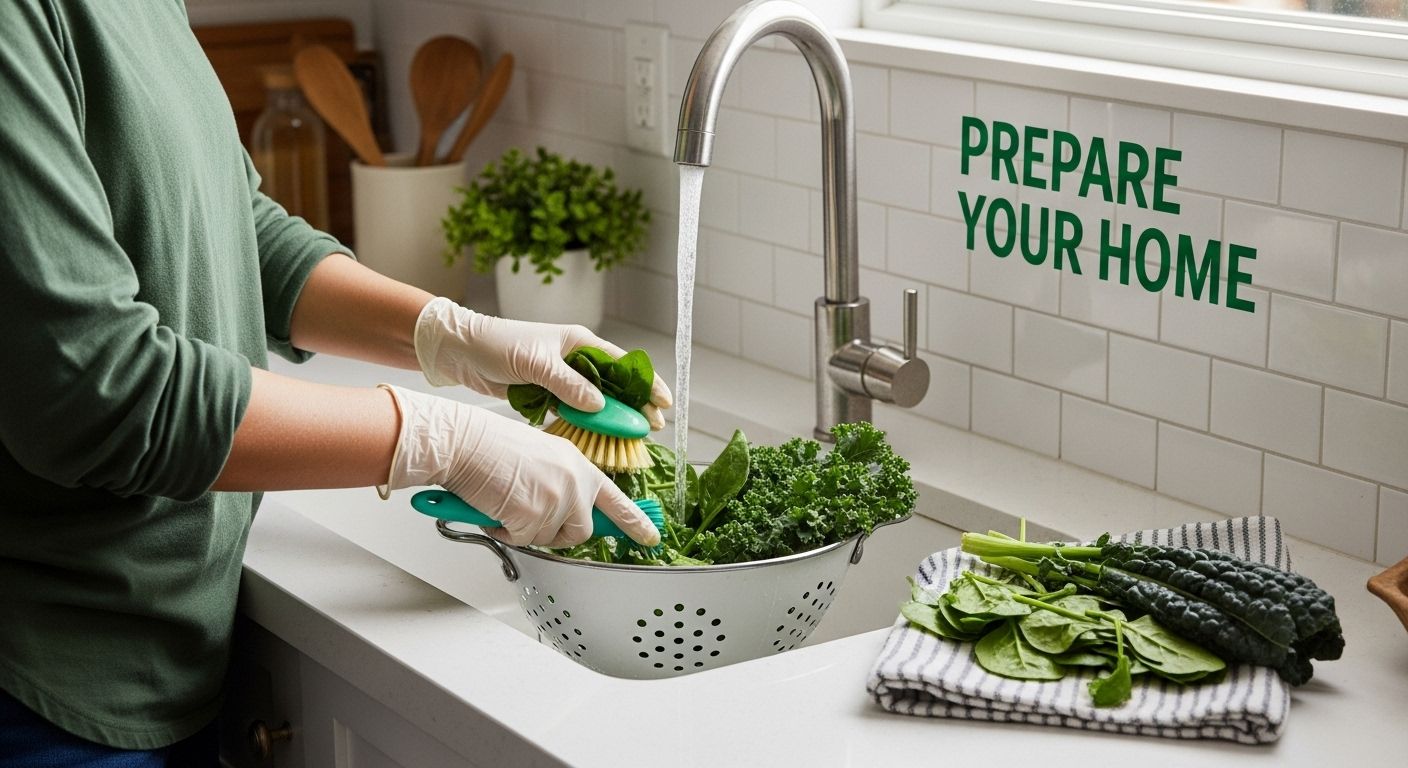 Use glass or ceramic containers with tight-sealing lids to prevent cross-contamination. Refrigerate washed produce promptly to maintain freshness and reduce potential chemical interaction.
Use glass or ceramic containers with tight-sealing lids to prevent cross-contamination. Refrigerate washed produce promptly to maintain freshness and reduce potential chemical interaction.
The following table summarises essential tools and materials you should have ready for effective at-home produce washing and pesticide removal, along with their specific purposes.
| Tool/Material | Purpose | Notes |
|---|---|---|
| Soft-bristled brush | Mechanically removes dirt and residues | Ideal for firm produce such as potatoes and carrots |
| White vinegar | Natural cleaning solution | Mix with water; avoid overuse on delicate produce |
| Large colander | Rinsing produce thoroughly | Useful for washing multiple items at once |
| Clean cutting board | Safe preparation space | Prevents surface contamination |
| Glass/ceramic container | Proper produce storage | Helps avoid cross-contamination after washing |
| Cool running water | Essential for rinsing and soaking | The primary recommended method for all produce |
Key verification criteria for kitchen pesticide reduction include:
- Implementing consistent produce washing techniques
- Using natural cleaning solutions
- Maintaining clean food preparation surfaces
- Storing produce strategically to minimise chemical transfer
Successful completion of this step means establishing a home environment that actively reduces pesticide exposure through mindful cleaning, storage, and food preparation practices.
Step 5: Implement Safe Food Washing Techniques
Effective food washing serves as a critical defence mechanism against pesticide residues, transforming your produce cleaning routine into a strategic health intervention. This step goes beyond simple rinsing, requiring methodical approaches tailored to different types of fruits and vegetables.
Systematic Produce Decontamination
Water temperature and mechanical action are your primary tools in removing pesticide residues. Different produce types demand unique washing strategies. Firm vegetables like potatoes and carrots benefit from gentle scrubbing with a clean vegetable brush, while delicate berries require more nuanced handling. Always wash produce immediately before consumption to prevent potential bacterial growth during storage.
Establish a dedicated washing station in your kitchen equipped with essential tools. Invest in a clean cutting board, soft-bristled vegetable brush, and large colander. Create a simple but effective cleaning solution using white vinegar diluted in water. For most produce, a mixture of three parts water to one part vinegar provides an excellent natural cleaning method. Soak produce for two to five minutes, then rinse thoroughly under cool running water.
According to guidance from the U.S. Food & Drug Administration, running water remains the most recommended method for produce cleaning. Importantly, avoid using soap or commercial produce washes, which can introduce additional chemicals.
Key verification criteria for safe food washing include:
- Using clean, running water for rinsing
- Employing mechanical scrubbing for firm produce
- Avoiding soap or commercial cleaning agents
- Washing produce immediately before consumption
Successful completion of this step means developing a consistent, scientifically-informed approach to produce cleaning that significantly reduces potential pesticide exposure while maintaining food safety and nutritional integrity.
Step 6: Verify Your Food Choices Regularly
Maintaining a pesticide-free diet requires ongoing vigilance and systematic review of your food sources and purchasing habits. This final step transforms your approach from a one-time intervention to a sustainable, adaptive strategy for minimising chemical exposure.
Continuous Food Safety Monitoring
Establishing a quarterly review of your food procurement methods becomes crucial in maintaining low pesticide intake. Create a personal tracking system that documents your current organic sources, certification details, and agricultural providers. Set calendar reminders every three to four months to reassess your food supply chain, checking for changes in agricultural practices, new organic certifications, or emerging research about specific produce categories.
Utilise digital and physical resources to stay informed. Subscribe to reputable agricultural newsletters, follow organic farming organisations on social media, and bookmark scientific websites that provide updates on pesticide research. Technology can be a powerful ally in maintaining food safety awareness. Mobile applications that provide real-time information about organic certifications and pesticide levels can help you make informed decisions quickly.
According to research from the European Food Safety Authority, continuous monitoring of food safety is essential in managing potential chemical exposure risks. Regular verification helps consumers adapt to changing agricultural landscapes and emerging scientific understanding.
Below is a checklist table to help you verify that you have completed each key criteria for ongoing low-pesticide food selection and safety monitoring.
| Verification Step | Frequency | Method/Notes |
|---|---|---|
| Review food sources | Quarterly | Research suppliers and local providers |
| Track organic certifications | Quarterly | Check for updated certification details |
| Stay updated with latest pesticide research | Ongoing | Subscribe to reputable news sources |
| Maintain adaptive food selection approach | Ongoing | Be prepared to change sources if needed |
| Document procurement practices | Quarterly | Keep a personal record for tracking |
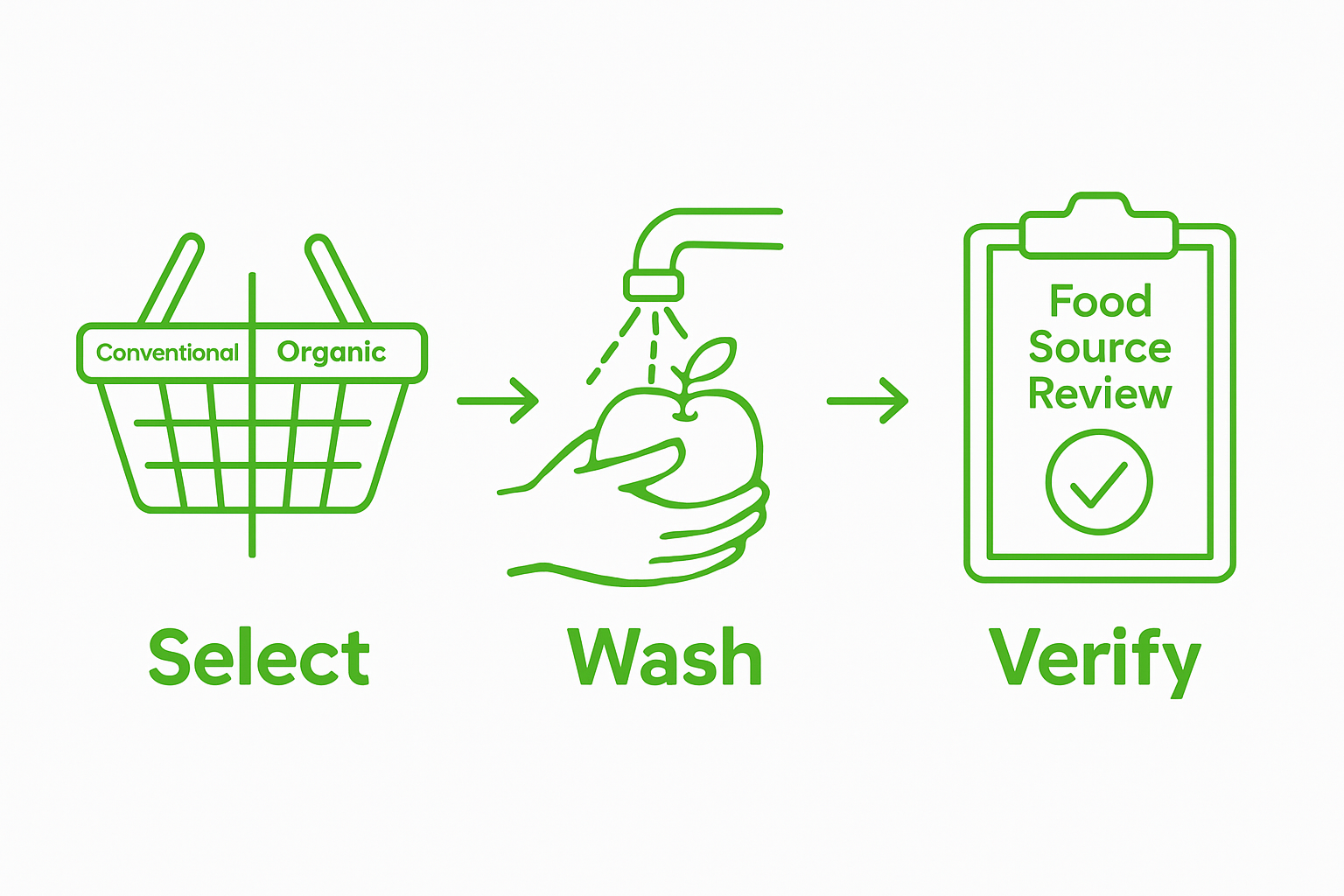
Key verification criteria for ongoing food choice assessment include:
- Quarterly review of current food sources
- Tracking changes in organic certifications
- Staying updated with latest pesticide research
- Maintaining a flexible, adaptive approach to food selection
Successful completion of this step means developing a proactive, knowledge-driven approach to food selection that prioritises your health through continuous learning and strategic decision-making.
Take Real Control of What Enters Your Home and Your Body
Navigating the maze of pesticides and hidden chemicals in your daily purchases can feel overwhelming. This complete guide has shown how crucial it is to understand food labels and certifications, choose truly organic options, and scrub your produce with care. But achieving a pesticide-free lifestyle is tough without trusted sources for clean and natural products. Now is the moment to protect your health and truly support your new kitchen habits by shopping smarter.
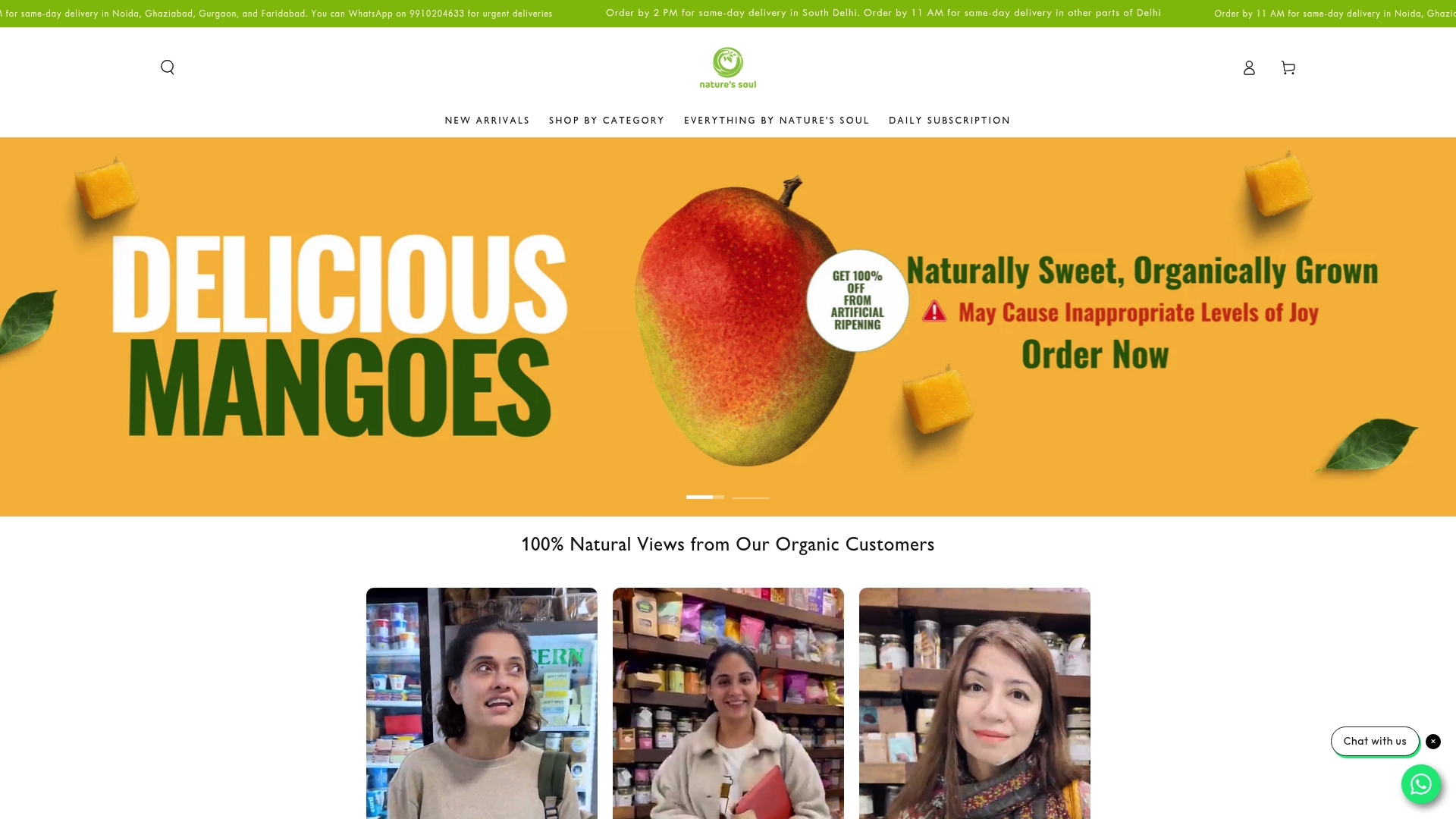
With Natures Soul Shop, you gain access to a wide range of organic and natural choices including fresh produce, meats, dry grocery, home care and skin care. Every item is selected with your well-being in mind and made to fit seamlessly into the steps you have learnt. Make your commitment to a healthier you. Visit Natures Soul Shop today and discover how easy it is to prioritise genuine wellness at every meal. Your journey towards a cleaner kitchen and a safer lifestyle starts now.
Frequently Asked Questions
How can I reduce my exposure to pesticides in fruits and vegetables?
You can reduce pesticide exposure by researching local produce sources, choosing organic and pesticide-free options, and understanding food labels and certifications. Washing your produce thoroughly and preparing your kitchen environment carefully also play essential roles.
What is the importance of understanding food labels when it comes to pesticides?
Understanding food labels helps distinguish between different certification standards, such as USDA Organic or Certified Naturally Grown. This knowledge can significantly reduce pesticide intake by ensuring you’re choosing produce that meets rigorous safety standards.
What are the best methods for washing produce to remove pesticides?
The best methods include using clean, running water and mechanical scrubbing for firm produce like potatoes and carrots. A solution of three parts water to one part vinegar can also effectively clean most fruits and vegetables.
How often should I review my food sources to maintain a low pesticide diet?
It is recommended to conduct a quarterly review of your food sources. This allows you to stay updated on any changes in agricultural practices, organic certifications, and emerging research related to pesticides.


